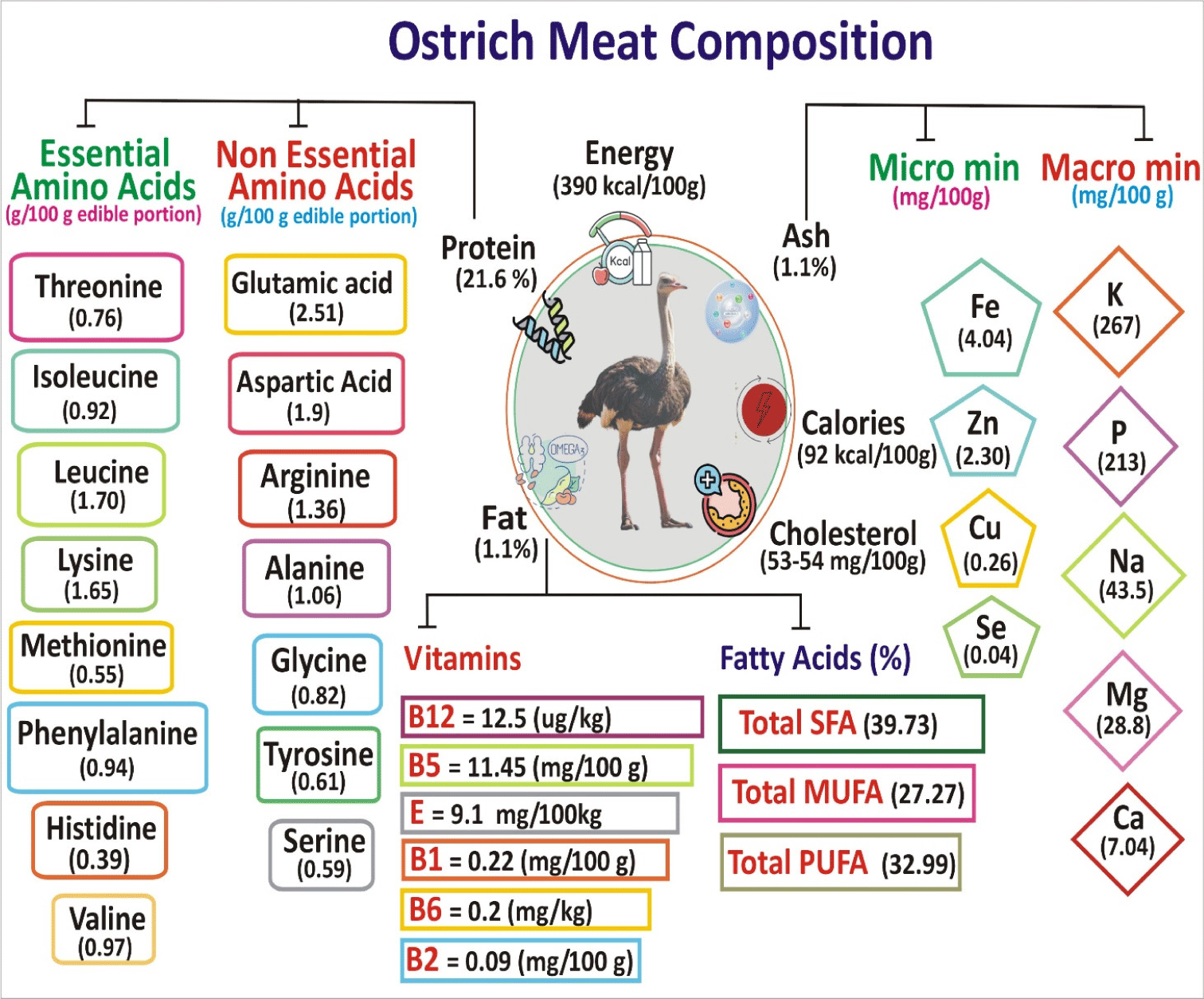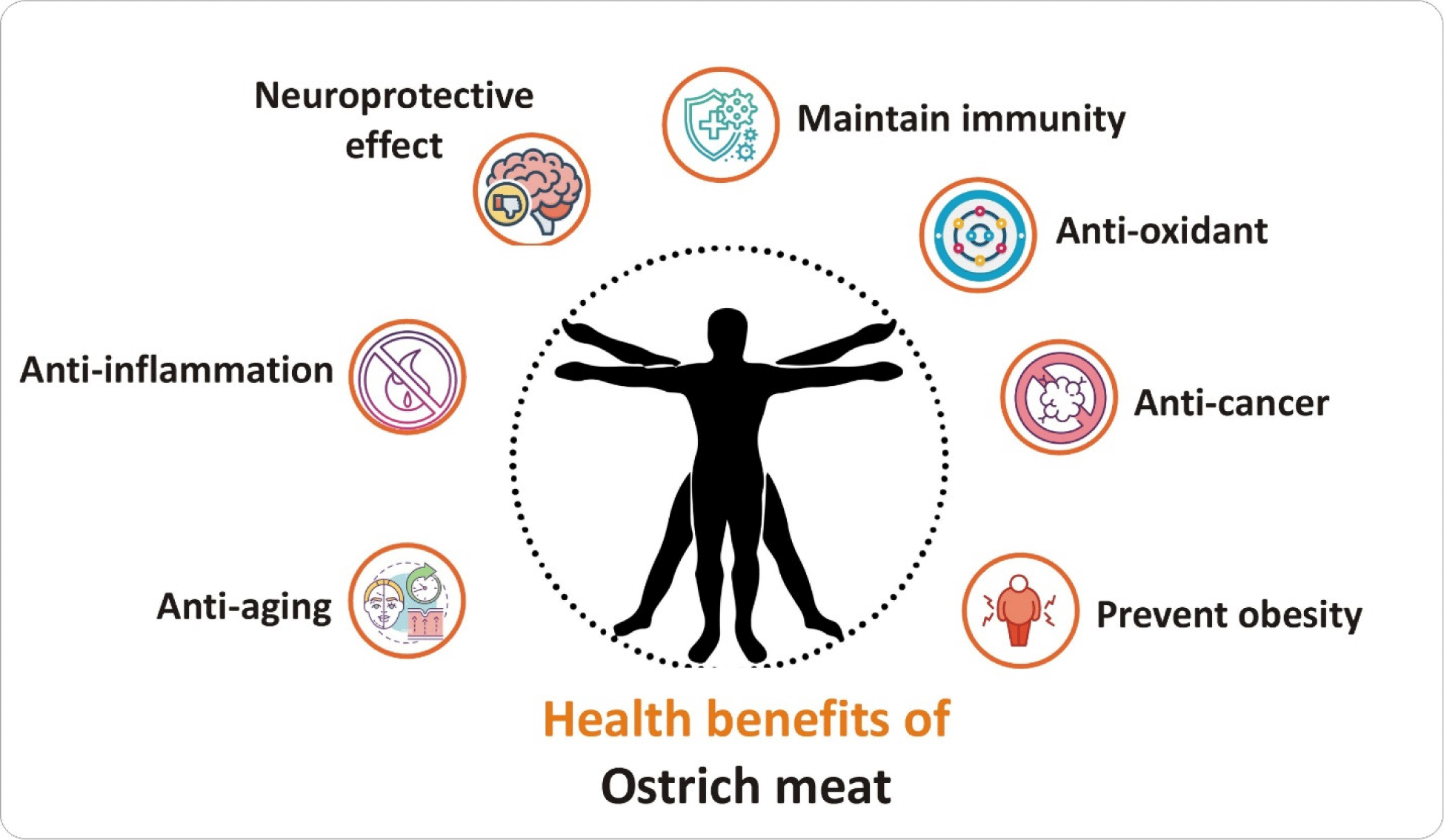Introduction
Ostrich is the largest flightless bird that belongs to the phylum Chordata and order Ratite. The average adult height is up to 2.8 meters (9.2 feet). The average weight is around 90 kg (198 pounds), making it considered the largest bird species on Earth (Cooper, 2000; Ramesh et al., 2021). The practice of ostrich farming has deep historical roots, dating back thousands of years to various regions of Africa and the Middle East. Ostriches are the world’s largest flightless birds, and their domestication for their meat, feathers, and leather has evolved over centuries (Buffetaut and Angst, 2022; Cooper, 2000). In the late 19th and early 20th centuries, commercial ostrich farming began to take shape in countries like South Africa and the United States (Hoffman et al., 2014; Moreki et al., 2021). The demand for ostrich feathers, which were highly valued in the fashion industry, was the driving force behind this (Kekana et al., 2023). As the demand for feathers decreased, ostrich farming turned its attention to producing meat.
Health-conscious consumers are increasingly attracted to functional food like meat and milk, owing to its low fat content, favorable lipid profile, and high-quality protein, making it a nutritious alternative to animal based food (Arain et al., 2025; Ashraf et al., 2024; Li et al., 2022). Ostrich meat contains lower cholesterol and saturated fat compared to beef and mutton, while offering comparable or superior essential amino acid profiles, making it ideal for those individuals aiming to reduce cardiovascular disorders (Horbańczuk and Wierzbicka, 2016). In addition to their nutritional benefits ostriches contributed to food diversification by supplying both meat and eggs, thereby enhancing food security food security in harsh regions with limited livestock options. Ostrich naturally adopted extreme temperature and arid climates make them highly suitable for farming in arid and semiarid areas of the world. Moreover, ostrich farming is considered a resource efficient compared to broiler and other traditional livestock, requiring less land, water and feed, which collectively minimize environmental impact (Anwar et al., 2023c; Farooq et al., 2023). Additionally, ostriches produce less greenhouse gas emission compared to ruminants, positioning them eco-friendly and environmentally sustainable source of animal food. The convergence of nutritional benefits, environmental sustainability, and adaptability promoted the groing global interest in ostrich farming and meat consumption (Henchion et al., 2017).
Growing awareness of the environmental and health impact of dietary choice has led consumers to seek sustainable and nutritious protein alternatives, including plant-based sources, cultured meat and unconventional animal proteins (Saeed et al., 2025a; Wei et al., 2021). In this evolving dietary landscape, poultry derived meat is gaining traction as a compelling alternative to conventional meat such as beef, pork and mutton, specially amid rising concerns over climate change (Arain et al., 2018; López-Pedrouso et al., 2019; Nabi et al., 2020; Saeed et al., 2025b). Studies indicate that ostrich meat acquires superior nutritional profile and contain lower content of sodium and cholesterol, higher content of iron, that promoted the suitable dietary option for those suffering in hypertension and anemia (Al-Khalifa and Al-Naser, 2014). Furthermore, the protein quality of ostrich meat is resembled to that of beef and chicken meat, which make it a versatile option for culinary applications (Al-Hoshani et al., 2023). Apart from providing all necessary nutrients, ostrich meat contains favorable concentration of omega-3 and omega-6 polyunsaturated fatty acids (PUFAs), which contributes to lower the risk of chronic disease such as cardiovascular disorders (Antunes et al., 2018). However, widespread adoption of ostrich meat faces certain economic challenges. Due to short-scale production, high rearing and processing costs, and the need for specialized farming practices, ostrich meat often marketed price (85 USD per kg) in several regions of the world. However, scaling up production and integrating advanced breeding techniques, including genetic selection and biotechnological interventions, may enhance productivity and cost-efficiency, ultimately making ostrich meat more accessible to the mainstream market. The present study aims to improve awareness regarding the nutritional value, physicochemical composition, and health benefits of ostrich meat, benefiting the human population.
Chemical Characteristics of Ostrich Meat
Recently, with the increasing interest of consumers in health and nutrition, the importance of food’s nutritional value has gained greater attention. During the last decade, ostrich meat has received significant attention due to its lower fat and cholesterol content, as well as its beef-like flavor compared to broiler meat (Al-Khalifa and Al-Naser, 2014). Furthermore, ostrich meat considered as a red meat with superior health promoting potential, because it contains higher concentration of polyunsaturated fat, and lower level of cholesterol and saturated fat in compression to the traditional red meat like beef (Abzhanova et al., 2023). Additionally, it was reported that ostrich meat contains higher iron levels and lower sodium content than other types of meat, making it a desirable choice for consumers suffering from anemia and hypertension (Al-Khalifa and Al-Naser, 2014).
Proximate Composition of Ostrich Meat
Although the overall chemical composition of important nutrients, such as water and protein, in ostrich meat may be comparable to that of broiler meat (Anwar et al., 2023a), a considerable difference was observed in fat and cholesterol content (Sales, 1996). Besides the macronutrients, notable differences were reported in the micronutrient content and molecular structure of the main components, such as fatty acids and amino acids profile of ostrich meat (Özsaraç et al., 2013). The gross chemical composition of ostrich meat was depicted in Fig. 1. In general, the protein and ash level was comparable across ratite birds (Hoffman et al., 2014). Similar trends were observed in terms of fat content, as ostrich meat contains 1–2 g/100 g fat, markedly lower than beef (10–15 g/100 g; Table 1). Ostrich meat has a much lower fat level compared to other red meats (Poławska et al., 2012), making it particularly appealing to weight-conscious customers.

| Composition | Ostrich | Chicken | Beef |
|---|---|---|---|
| Protein (g/100 g) | 22–24 | 20–23 | 19–22 |
| Fat (g/100 g) | 2–3 | 2–5 | 10–15 |
| Cholesterol (mg/100 g) | 60–70 | 70–85 | 70–90 |
| Moisture (%) | 75–77 | 65–70 | 55–65 |
| Ash (%) | 1.1 | 1.0 | 1.0 |
Nutritional Value of Ostrich Meat
Table 2 shows that the cholesterol level in ratite meat, especially ostrich meat, is typically low and lower than that of beef and chicken meat (Horbañczuk et al., 1998). The recorded values for unprocessed ratite meat ranged from 53–54 mg/100 g in ostrich, 58 mg/100 g in chicken, and 56–81 mg/100 g in beef (Poławska et al., 2011). The primary function of cholesterol is to be a fundamental element in the structure of cell membranes. Arteriosclerosis is associated with individuals who retain cholesterol in their blood arteries, which increases their risk of heart attack, as indicated by compelling data. Cholesterol-phobia is a prevalent occurrence in wealthy nations.
Ostrich meat has a reduced calorific value of 390 kJ/100 g compared to chicken (121 kJ/100 g) and beef (517 kJ/100 g) as shown in Table 2. These characteristics make ostrich meat a great source of lean protein. According to the World Health Organization (WHO) guidelines (WHO, 2003), it is advised that only 30% of daily energy intake should be derived from fat. Therefore, ostrich meat may serve as a beneficial protein source with a low caloric content.
The fatty acid composition of ostrich, chicken, and beef meat is shown in Table 2. The fatty acid profile of ostrich meat is superior to that of beef and chicken. Numerous studies have reported that the fatty acid profile of ostrich fat differs among the various muscle groups of the same carcass (Balog and Almeida Paz, 2007). Another study evaluated the fat content and fatty acid profile in three different muscles of the pelvic limb, including M. gastrocnemius, M. iliofibularis, and M. iliotibialis, slected on the basis of economic value and substantial mass (Girolami et al., 2003). Results showed that the highest intramuscular fat (2.26 g/100 g) was recorded in M. iliotibialis, followed the M. gastrocnemius (1.24 g/100 g) and M. iliofibularis (1.99 g/100 g) respectively (Girolami et al., 2003). However, the results of total lipid, as well as the percentage of saturated and monounsaturated fatty acids, showed no significant difference, while the PUFA was higher in M. iliofibularis compared to the other muscles. Additionally, the ratio of omega-6 to omega-3 fatty acids in M. iliofibularis was lowered than rest of the muscle (Horbañczuk et al., 1998).
In recent years, PUFAs have attracted significant attention in both human and animal nutrition, notably those of the omega-3 family (omega-3 fatty acids; Saini and Keum, 2018). In general, human intake of n-3 fatty acids is often low, especially for long-chain (>18 carbon atoms) fatty acids that are present in fish and seed oils. For instance, the PUFA content in ratites is much greater than that in chicken meat, with levels of 19%, compared to beef which has a PUFA concentration of 4.8% (Turner et al., 2015). Despite this, ostrich meat was discovered to possess approximately 8% of n3, which is the most significant source of valuable fatty acid in the human diet (Hoffman et al., 2005). This quantity is two times higher than those found in emu (3%) and rhea meat (4.5%), and much higher than those found in chicken meat (2.4%) and beef (0.6%; Filgueras et al., 2010). A similar trend was observed in the case of linolenic acid (18:3). The levels of docosahexaenoic acid (DHA; 22:6) and eicosapentaenoic acid (EPA; 20:5) n-3 PUFA in ostrich meat are greater than those in beef and chicken meat (Table 2; Naveena et al., 2015).
Long-chain n-3 PUFAs particularly EPA and DHA, are essential for human health, playing critical roles in brain development, visual function, and cardiovascular health (Calder, 2018; Ruxton et al., 2005; Zhang et al., 2023). Dietary inclusion of DHA has been shown to significantly support the structural and functional development of the brain and liver in infants, underscoring its importance during early growth stages (Poławska et al., 2011; Poławska et al., 2013b; Saeed et al., 2021). Notably, ostrich meat exhibits a highly favorable n-6/n-3 PUFA ratio, superior to that of conventional meats like beef and chicken, making it an excellent dietary source of health-promoting fats (Zdanowska-Sąsiadek et al., 2018). Feeding strategies involving the supplementation of fish oil, linseed and other n-6/n-3 PUFA enriched supplementation in their diets have been shown to further enhance the muscle fatty acid profile by increasing the levels of EPA and DHA, thereby improving the nutritional value of the meat (Poławska et al., 2013a; Poławska et al., 2016; Saeed et al., 2021). The emphasis on achieving an optimal n-6/n-3 PUFA ratio in meat is particularly relevant given the imbalanced fatty acid profiles typical of Western diets. The current Western dietary ratio of n-6 to n-3 fatty acids is approximately 15:1 to 16:1 far exceeding the WHO’s recommended upper limit of 4:1 (Simopoulos, 2008). Excessive intake of n-6 PUFAs, particularly linoleic acid, relative to n-3 PUFAs has been implicated in the pathogenesis of numerous chronic conditions, including cardiovascular disease, certain cancers, autoimmune disorders, osteoporosis, and inflammatory diseases (Hussain et al., 2023; Simopoulos, 2006). Conversely, increasing dietary intake of long-chain n-3 PUFAs and functional foods has demonstrated anti-inflammatory effects and potential protective roles against these conditions (Arain et al., 2023; Arain et al., 2024a; Harris, 2018). Therefore, the promotion of ostrich meat with its naturally lower n-6/n-3 ratio may offer a strategic dietary intervention to help mitigate the health risks associated with n-3 PUFA deficiency in modern diets.
Ostrich meat is considered a significant mineral source, particularly for selenium, copper, and iron (Table 3). As an example, the iron level in ostrich meat exceeded 4 mg/100 g, whereas this levels are above the typical range stated for chicken meat (0.4–0.6 mg/100 g) and are also higher than those for beef (1.7–2 mg/100 g; Majewska et al., 2009). In addition, Walter et al. (2000) conducted a study comparing the amount of iron in ground ostrich meat with ground beef. They discovered that the ostrich meat contained higher amount of iron compared to the beef (Walter et al., 2000; Yonei et al., 2024). Iron insufficiency is the most common nutritional issues in the worldwide, particularly in developing nations (Charles, 2012). Currently, around 600–700 million individuals globally are experiencing iron shortages, as reported by the WHO. The bioavailability of iron in meat and meat products is reported higher than that of iron from plants, with red meats ranging from 72% to 87% (Li et al., 2024; Lombardi-Boccia et al., 2002). Therefore, ostrich meat seems to be a very beneficial dietary source of both total iron and heme iron (Majewska et al., 2009; Rogozina et al., 2021). As mentioned before, ostrich meat is a superior source of copper and selenium than traditional meats like beef or chicken (Table 3). When comparing ratites, it is evident that the ostrich (0.26 mg/100 g) has a greater copper content compared to other meat. In comparison to other meat producing species, ostrich meat stands out for its low sodium content of 43 mg/100 g. This makes ostrich meat a suitable choice for those following hypertension diets. The new recommendation is to decrease sodium consumption in order to control arterial hypertension, particularly in individuals who are sensitive to sodium (Whelton et al., 2012).
There is currently limited literature presenting scientific data about the vitamin composition of ostrich meat (Yonei et al., 2024). The available data on the vitamin content and composition of ostrich and meat is limited, and findings need to be verified by more comprehensive investigations in future studies. According to the data found in global literature, it can be concluded that ostrich meat has more B-group vitamins than beef and chicken meat. Ostrich meat contained the highest amount of vitamin B12. The vitamin E content of ostrich meat was in line with that of beef and chicken meat (Brassó et al., 2021; Henry et al., 2024).
Physical Characteristics of Ostrich Meat
Ostrich meat exhibits unique physicochemical properties that distinguish it from conventional meats such as broiler chicken or beef. It is characterized by a deep red color, fine-grained texture, and notably low intramuscular fat content. The rich red hue, akin to that of beef, is attributed to a higher concentration of myoglobin a muscle pigment responsible for oxygen transport and meat coloration compared to the lighter appearance of broiler meat (Cooper and Horbañczuk, 2002). The texture of ostrich meat is fine yet slightly firmer than that of broiler meat, which has been attributed to differences in muscle fiber structure and connective tissue content (Jukna and Valaitienė, 2012). It has a mild, slightly sweet flavor, which appeals to health-conscious consumers seeking leaner red meat alternatives. Compared to broiler meat, ostrich meat shows superior moisture retention during cooking, as evidenced by lower cooking loss an indicator of better water-holding capacity enhancing both juiciness and tenderness after heat treatment (Elhashmi et al., 2021). From a lipid profile perspective, ostrich meat contains significantly lower levels of intramuscular fat. These attributes collectively position ostrich meat as a nutritionally advantageous and functionally desirable alternative to conventional red and white meats.
Health Benefits of Ostrich Meat
Ostrich meat represents a popular nutritional choice because it provides consumers with lean red meat that carries multiple beneficial health aspects (Fig. 2). The substantial protein concentration in ostrich meat support muscle protein synthesis, making it particularly beneficial for athletes and fitness professionals focused on muscle development and recovery (Medina and Aguilar, 2014). Moreover, it contained all essential amino acids in balance proportion, which are curtail for numerous physiological functions, including tissue repair, enzyme activity and immune responses. One of the most distinctive nutritional advantages of ostrich meat is lower content of fat. In comparison to chicken and beef, ostrich meat is significantly leaner, making it optimal choice for individuals aiming to reduce their intake of saturated fats. Notably, the smaller amount of fat present in ostrich meat is predominantly unsaturated fat, which has been show to positively influence lipid profiles by reducing low density lipoproteins cholesterol and lowering the risk of cardiovascular disease (Riediger et al., 2009). Additionally, the low caloric density of ostrich meat support weight management efforts by providing essential nutrients without excessive energy intake.
Ostrich meat also rich in essential micronutrients, contributing to its role in promoting overall health. It serves as excellent source of bioavailable iron, which is critical for preventing iron-deficiency anemia and promoting the synthesis of hemoglobin and red blood cells (Anwar et al., 2023b). Moreover, it contains higher concentration of zinc, a trace element vital for immune function, wound healing and DNA synthesis. Vitamin B12 abundant in ostrich meat, which contribute neuroprotective and immune boosting benefits. Additionally, ostrich meat contains selenium, a potent antioxidant that contributes to the maintenance of cellular integrity by neutralizing free radicals. Selenium also plays a central role in thyroid hormone metabolism and immune defense (Ahmad et al., 2023). The fatty acid profile of ostrich meat includes omega-3 and omega-6 PUFAs, which possess anti-inflammatory properties, promote joint health, and may help reduce the risk of chronic diseases such as type 2 diabetes and cardiovascular disorders (Riediger et al., 2009). Furthermore, its high choline content supports brain development, cognitive performance, and neurotransmitter synthesis.
The consumption of ostrich meat offers a nutritionally valuable alternative to conventional red meats, characterized by its low fat content and high protein quality. Notably, ostrich meat is a rich source of omega-3 fatty acids and natural antioxidants, both of which contribute to its health-promoting properties (Poggioli et al., 2023). Omega-3 fatty acids, particularly EPA and DHA, are renowned for their potent anti-inflammatory effects. These fatty acids modulate immune function by downregulating the production of pro-inflammatory cytokines and eicosanoids (Cai et al., 2024; Calder, 2013). Moreover, they contribute to the resolution of inflammation through the synthesis of specialized pro-resolving mediators, which actively terminate inflammatory responses and promote tissue healing (Balachander, 2024).
Clinical evidence further supports the therapeutic potential of omega-3 fatty acids, demonstrating their efficacy in reducing disease activity in inflammatory and cardiovascular conditions, such as rheumatoid arthritis and atherosclerosis (Poggioli et al., 2023). Alongside these fatty acids, ostrich meat contains significant levels of antioxidants, including vitamins E and C, which help combat oxidative stress—a known contributor to chronic inflammation and various degenerative diseases (Prates, 2025). Antioxidants neutralize free radicals, thereby protecting cellular structures from oxidative damage and supporting overall metabolic health. Importantly, the balance between dietary omega-3 and omega-6 fatty acids plays a critical role in regulating inflammatory responses. Western diets are typically high in omega-6 fatty acids, which can promote inflammation when consumed in excess. Therefore, incorporating omega-3-rich foods such as ostrich meat can help restore this balance and mitigate the pro-inflammatory effects of omega-6s (Poggioli et al., 2023). Despite these benefits, it is essential to acknowledge that excessive consumption of red meat—regardless of its source has been associated with increased risks of cardiovascular and metabolic disorders. This underscores the importance of moderation and the inclusion of lean, nutrient-dense meats like ostrich as part of a balanced diet (Prates, 2025).
Conjugated linoleic acid (CLA) refers to a group of positional and geometric isomers of linoleic acid (C18:2), primarily found in the meat and fat of ruminants. Recent studies have identified ostrich meat as a notable source of CLA, with concentrations ranging from 0.37 to 1.08 g per 100 g of muscle tissue (Abbas and Alkheraije, 2023; Du et al., 2024; Rogozina et al., 2021). CLA has garnered significant scientific attention due to its potential bioactive properties, particularly its anti-carcinogenic, anti-atherogenic, and immune-modulatory effects, as demonstrated in both animal models and human studies (Yang et al., 2015). These effects are thought to be mediated through mechanisms involving peroxisome proliferator-activated receptors, modulation of lipid metabolism, and regulation of inflammatory pathways. Although dietary intake of CLA from ostrich meat can contribute to circulating CLA levels in humans, it remains uncertain whether the levels achievable through typical dietary consumption are sufficient to exert clinically meaningful effects (Badawy et al., 2023). Nonetheless, the presence of CLA enhances the functional food profile of ostrich meat. Given its favorable nutrient composition and lipid profile, ostrich meat aligns with contemporary dietary recommendations aimed at reducing saturated fat intake while ensuring adequate intake of iron and protein, making it a promising alternative to traditional red meats.
Global Availability and Future Prospects
Ostrich meat production, both presently and in the future, is intricately linked to evolving consumer dietary preferences and the adoption of sustainable and ethical farming practices by producers. Currently, the primary centers of ostrich meat production and consumption are located in established ostrich farming regions such as South Africa, the United States, and Australia, with South Africa being the global leader in commercial ostrich farming (Adams and Revell, 2003; Shami et al., 2024). Growing public awareness of the nutritional advantages of ostrich meat such as its high protein content, low fat, and favorable fatty acid profile alongside its lower environmental footprint compared to traditional livestock, is fostering increasing demand (Horbańczuk and Wierzbicka, 2016; Sales, 1996). The future expansion of ostrich farming hinges on several key factors: advances in ostrich husbandry and breeding technologies, optimization of feed and health management to reduce production costs, and the development of international trade routes and export markets (Abbas et al., 2018). As a niche but emerging protein source, ostrich meat marketing strategies should emphasize its health-promoting attributes and environmental sustainability to attract health-conscious and eco-aware consumers. Offering competitive pricing through economies of scale, coupled with targeted education and promotional campaigns, can further stimulate demand (Alqahtani et al., 2024). Ostrich meat production has exhibited a consistent global increase from 2000 to 2025, driven by rising consumer demand and population growth (Fig. 3). In 2024, China led global production with approximately 0.6 million tons, followed by Brazil (0.35 million tons), South Africa (0.2 million tons), and Pakistan (0.15 million tons). The upsurge in ostrich farming is attributed to the meat’s health benefits (Sales, 1996).

South Africa remains a global leader, producing about 70% of the world’s ostrich meat and generating around R1,200 million in export revenue, contributing 5% of total agricultural exports (Brand and Jordaan, 2011). The sector supports roughly 20,000 jobs, especially in rural communities, stimulating local economies through infrastructure and processing plant investments. Ostrich farming is considered more efficient than traditional livestock systems, as hens can produce up to 25 offspring annually, reflecting favorable reproductive and feed conversion metrics (Brown and Thompson, 1996). Ostrich meat is gaining popularity in non-traditional markets like Turkey, where its high protein and favorable lipid profile are increasingly appreciated (Serdaroğlu and Turp, 2001). Technological advancements and cost-effective rearing practices are enhancing production efficiency, while government support and ethical farming are helping integrate ostrich meat into mainstream markets. With continued investment in consumer education and sustainable practices, ostrich farming is transitioning from a niche sector to a globally viable solution for lean, nutritious, and environmentally friendly meat production (Lambooij and Pieterse, 2000).
Conclusion
Ostrich meat presents a nutritionally superior alternative to conventional red meats, offering multiple health benefits backed by scientific evidence. It is rich in high-quality protein and low in total fat, particularly saturated fat, making it suitable for individuals aiming to manage weight or reduce cardiovascular risk. Moreover, ostrich meat contains a favorable balance of PUFAs, including omega-3 and omega-6, which are essential for heart and brain health. Its high concentrations of bioavailable minerals such as iron, zinc, and selenium contribute to improved immune function, oxygen transport, and antioxidant defense. Notably, its lower cholesterol content further enhances its cardiovascular appeal. These attributes make ostrich meat both a nutritionally dense and functionally valuable food. Future research should focus on improving consumer awareness, developing cost-effective rearing practices, and establishing supportive policies to facilitate its integration into global food markets and sustainable dietary frameworks.














